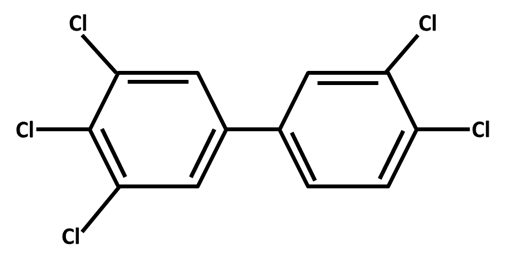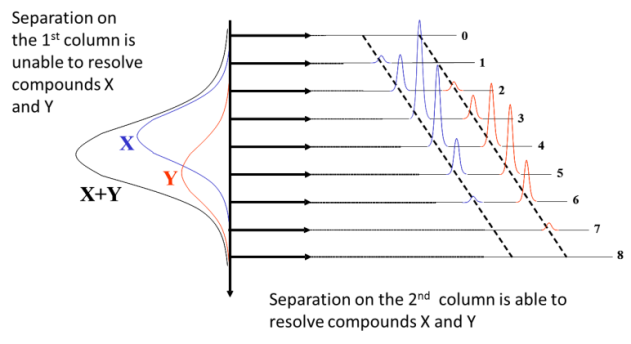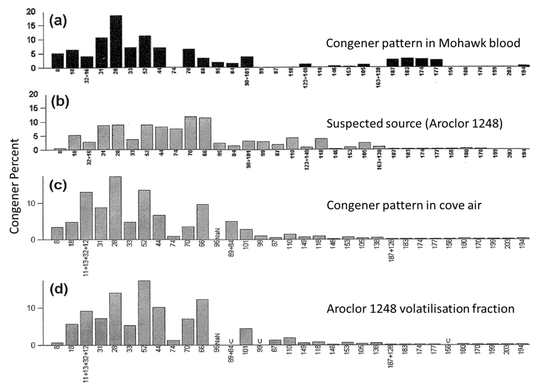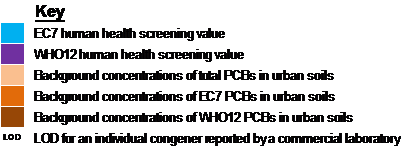PCB analysis, risk assessment and forensic techniques in UK contaminated land assessments
|
David Megson
School of Geography, Earth and Environmental Science, Plymouth University [email protected] |
ECG Bulletin January 2014
This article provides an overview of the current state of PCB analysis, risk assessment and forensic techniques in contaminated land assessments undertaken in the UK today. It provides a discussion on the merits and drawbacks of the current situation and provides advice on how improvements can be achieved.
|
Introduction
Polychlorinated biphenyls (PCBs, Figure 1) are a group of 209 chlorinated organic compounds that were widely used in the 20th century for a variety of industrial uses, including dielectric fluids, hydraulic fluids and plasticisers. PCBs were first produced in the 1930s and were manufactured until the 1970s and 80s, when their use was phased out because of environmental and human health risks (1, 2). PCBs are very stable compounds that do not readily degrade; they are persistent organic pollutants and are listed under the Stockholm convention as part of the “dirty dozen.” Even though the use of PCBs has been phased out, they are still routinely detected in soils and animal tissues at contaminated sites in the UK and across the globe (3, 4, 5). Findings from the UK soil and herbage survey (6) show that at the national scale, diffusive leakage from sealed and open primary sources, such as electrical equipment, is the main routes by which PCBs enter the environment. PCBs were synthesised as blends containing a mixture of different PCBs that were sold under trade names based on their chlorine content. The market leader for PCB production was Monsanto, a US based company. It manufactured PCB mixtures called Aroclors that account for more than half of the global total of roughly 1.2 million tonnes (7). |
Monsanto produced nine main Aroclors that accounted for 99.97% of production (8); each was identified with a four digit code. For example, Aroclor 1260 contained an end product with 60% chlorine by weight. Similar naming systems and production methods were used by other manufacturers; the proportions of congeners in Aroclor 1260, Clophen A60 and Kanechlor 600 are almost identical (2).
Some of the most comprehensive information on PCB use comes from the United States, where most PCBs were produced for capacitors (~45% of sales) and transformers (~25% of sales), with ~20% of sales attributed to plastics and hydraulic lubricants, and minor uses; the remaining ~10% were exported (8). Limited data are available for PCB use in the UK. The UK Soil and Herbage Survey (6) identified that approximately 66,500 tonnes of PCBs were manufactured between 1954 and 1977, of which around 27,000 tonnes were exported to other countries. However, there were no figures for quantities imported to the UK. Of the 40,000 tonnes of PCBs sold in the UK since 1954, only about 400 tonnes are now present in the environment, with the remainder either still in use, transported away from the UK, or degraded/transformed (6). Thus even with the cessation of production and use, risk assessment of PCBs remains an important issue in the UK.
Chemical analysis
Due to the structural similarity of PCBs, compound-specific analysis is a significant analytical challenge. Early methods for PCB analysis involved non-selective techniques such as gas chromatography electron capture detector (GC-ECD). These techniques normally involved the analysis of total PCBs in technical mixtures like Aroclors. However, pure technical mixtures are rarely present in the environment, because PCBs undergo post-depositional changes and are present along with other chemically similar contaminants. PCBs were first detected as interferences in organochlorine pesticide analysis in GC-ECD chromatograms, and it took almost seven years to identify and confirm PCBs as the environmental contaminants (9). Since the 1980s, advances in mass spectrometry have led to the development of congener specific methods. Bench-top quadrupole mass spectrometers became commercially available in the 1980s and are still present in most laboratories today. Quadrupole mass spectrometers are considered to be low-resolution instruments and are typically limited to unit mass resolution, which cannot distinguish between two similar compounds with a difference in atomic mass of less than 0.5 Da. The development of high resolution spectrometers such as time-of-flight mass spectrometers (TOF-MS) significantly improved the selectivity of PCB analysis.
In contaminated-land investigations, PCB are commonly analysed using GC-MS, which provides a relatively quick screen and can show whether a sample has been grossly contaminated. Limits of detection vary with different commercial laboratories but are generally in the range of 10 to 1000 µg kg-1; few labs can provide limits of detection below 1 µg kg-1. This can be a significant limitation, because background total PCB concentrations in UK urban soils are between 0.01 and 40 µg kg-1 (6). Sample clean-up and high-resolution mass spectrometry techniques can now remove many interfering compounds, such as dioxins, furans and organochlorine pesticides, but they cannot stop some PCBs from co-eluting with other PCBs.
The EC7 congener mixture is a set of PCBs, commonly encountered in environmental samples, consisting of PCBs 28, 52, 101, 118, 153 and 180 (10, 11). The co-elution of the EC7 compounds highlights of the main limitations of PCB analysis using GC-MS: the inability of the chromatography to fully resolve the target compound. The development of comprehensive two-dimensional GC (GCxGC-TOFMS) techniques solved most of these problems. By combining two GC columns with different stationary phases, it adds an extra dimension to the analysis (Figure 2). Using GCxGC-TOFMS, analysts can separate the target PCBs (12) with detection limits in the attogram range (10-18 g) (13). These techniques allow detection and quantification of individual PCB concentrations in humans from just a single blood spot.
Some of the most comprehensive information on PCB use comes from the United States, where most PCBs were produced for capacitors (~45% of sales) and transformers (~25% of sales), with ~20% of sales attributed to plastics and hydraulic lubricants, and minor uses; the remaining ~10% were exported (8). Limited data are available for PCB use in the UK. The UK Soil and Herbage Survey (6) identified that approximately 66,500 tonnes of PCBs were manufactured between 1954 and 1977, of which around 27,000 tonnes were exported to other countries. However, there were no figures for quantities imported to the UK. Of the 40,000 tonnes of PCBs sold in the UK since 1954, only about 400 tonnes are now present in the environment, with the remainder either still in use, transported away from the UK, or degraded/transformed (6). Thus even with the cessation of production and use, risk assessment of PCBs remains an important issue in the UK.
Chemical analysis
Due to the structural similarity of PCBs, compound-specific analysis is a significant analytical challenge. Early methods for PCB analysis involved non-selective techniques such as gas chromatography electron capture detector (GC-ECD). These techniques normally involved the analysis of total PCBs in technical mixtures like Aroclors. However, pure technical mixtures are rarely present in the environment, because PCBs undergo post-depositional changes and are present along with other chemically similar contaminants. PCBs were first detected as interferences in organochlorine pesticide analysis in GC-ECD chromatograms, and it took almost seven years to identify and confirm PCBs as the environmental contaminants (9). Since the 1980s, advances in mass spectrometry have led to the development of congener specific methods. Bench-top quadrupole mass spectrometers became commercially available in the 1980s and are still present in most laboratories today. Quadrupole mass spectrometers are considered to be low-resolution instruments and are typically limited to unit mass resolution, which cannot distinguish between two similar compounds with a difference in atomic mass of less than 0.5 Da. The development of high resolution spectrometers such as time-of-flight mass spectrometers (TOF-MS) significantly improved the selectivity of PCB analysis.
In contaminated-land investigations, PCB are commonly analysed using GC-MS, which provides a relatively quick screen and can show whether a sample has been grossly contaminated. Limits of detection vary with different commercial laboratories but are generally in the range of 10 to 1000 µg kg-1; few labs can provide limits of detection below 1 µg kg-1. This can be a significant limitation, because background total PCB concentrations in UK urban soils are between 0.01 and 40 µg kg-1 (6). Sample clean-up and high-resolution mass spectrometry techniques can now remove many interfering compounds, such as dioxins, furans and organochlorine pesticides, but they cannot stop some PCBs from co-eluting with other PCBs.
The EC7 congener mixture is a set of PCBs, commonly encountered in environmental samples, consisting of PCBs 28, 52, 101, 118, 153 and 180 (10, 11). The co-elution of the EC7 compounds highlights of the main limitations of PCB analysis using GC-MS: the inability of the chromatography to fully resolve the target compound. The development of comprehensive two-dimensional GC (GCxGC-TOFMS) techniques solved most of these problems. By combining two GC columns with different stationary phases, it adds an extra dimension to the analysis (Figure 2). Using GCxGC-TOFMS, analysts can separate the target PCBs (12) with detection limits in the attogram range (10-18 g) (13). These techniques allow detection and quantification of individual PCB concentrations in humans from just a single blood spot.
Human health risk assessment
The European Food Safety Agency (EFSA) (14) states that 130 of the 209 PCB congeners have been reported in various commercial preparations (such as Aroclors) and environmental samples. However, the UK preferred methodology for risk assessment is to look at the WHO12 (PCBs 77, 81, 126, 169, 105, 114, 118, 123, 156, 157, 167 and 189) congeners only. This subgroup comprises co-planar congeners that are believed to show a dioxin-like toxicity. The UK Environment Agency (15) does not consider the WHO12 to be carcinogens. It is believed that most of the toxic effects from dioxin-like PCBs result from their binding to the aryl hydrocarbon receptor, which can cause immune suppression, reproductive and developmental toxicity. Non-dioxin-like PCBs are also toxic and have been shown to elicit neurological, endocrine and immunological effects (14). The non-dioxin-like PCBs are ~5 times more abundant than the WHO12 in food (14) and ~4 times more abundant in soils (6). Therefore, many other worldwide organisations prefer to monitor both dioxin-like and non-dioxin-like PCBs.
The more common occurrence of EC7 over WHO12 congeners is primarily due to their greater percentage weight concentrations in commercial mixtures. The EC7 congeners make up ~20% by weight of PCBs in commercial Aroclor mixtures, whereas the WHO12 make up <4% by weight (Frame, 2001). Thus, even when taking into account degradation within environmental samples, the EC7 are more commonly found in higher concentrations in environmental and food samples.
The UK approach to human health risk assessment of PCBs is to screen and carry out detailed quantitative risk assessments using only the WHO12. However, due to their toxicity and higher environmental concentrations there is an argument for the non-dioxin-like PCBs to also be considered. Commercial laboratory analysis of the EC7 is less expensive and more likely to detect PCBs in measurable concentrations than analysis of the WHO12. Therefore, screening of contaminated land using the EC7 and detailed risk assessment using both the EC7 and WHO12 is likely to provide a clearer picture of the risks posed by PCBs to humans and the environment.
When considering human exposure pathways, vegetation uptake of PCBs from soil by plants is generally negligible; PCB concentrations in plants more closely reflect atmospheric deposition (16). Most PCB uptake from contaminated land in the UK is considered to be via the soil medium by direct contact with skin and by direct and indirect soil ingestion, with insignificant inhalation of particulates or vapour. For risk assessment purposes in the UK, only combined oral and dermal exposure is considered, with the assumption that the dominant pathway is the oral route. Therefore, a Tolerable Daily Intake (TDI) is set for this exposure pathway only (15).
The European Food Safety Agency (EFSA) (14) states that 130 of the 209 PCB congeners have been reported in various commercial preparations (such as Aroclors) and environmental samples. However, the UK preferred methodology for risk assessment is to look at the WHO12 (PCBs 77, 81, 126, 169, 105, 114, 118, 123, 156, 157, 167 and 189) congeners only. This subgroup comprises co-planar congeners that are believed to show a dioxin-like toxicity. The UK Environment Agency (15) does not consider the WHO12 to be carcinogens. It is believed that most of the toxic effects from dioxin-like PCBs result from their binding to the aryl hydrocarbon receptor, which can cause immune suppression, reproductive and developmental toxicity. Non-dioxin-like PCBs are also toxic and have been shown to elicit neurological, endocrine and immunological effects (14). The non-dioxin-like PCBs are ~5 times more abundant than the WHO12 in food (14) and ~4 times more abundant in soils (6). Therefore, many other worldwide organisations prefer to monitor both dioxin-like and non-dioxin-like PCBs.
The more common occurrence of EC7 over WHO12 congeners is primarily due to their greater percentage weight concentrations in commercial mixtures. The EC7 congeners make up ~20% by weight of PCBs in commercial Aroclor mixtures, whereas the WHO12 make up <4% by weight (Frame, 2001). Thus, even when taking into account degradation within environmental samples, the EC7 are more commonly found in higher concentrations in environmental and food samples.
The UK approach to human health risk assessment of PCBs is to screen and carry out detailed quantitative risk assessments using only the WHO12. However, due to their toxicity and higher environmental concentrations there is an argument for the non-dioxin-like PCBs to also be considered. Commercial laboratory analysis of the EC7 is less expensive and more likely to detect PCBs in measurable concentrations than analysis of the WHO12. Therefore, screening of contaminated land using the EC7 and detailed risk assessment using both the EC7 and WHO12 is likely to provide a clearer picture of the risks posed by PCBs to humans and the environment.
When considering human exposure pathways, vegetation uptake of PCBs from soil by plants is generally negligible; PCB concentrations in plants more closely reflect atmospheric deposition (16). Most PCB uptake from contaminated land in the UK is considered to be via the soil medium by direct contact with skin and by direct and indirect soil ingestion, with insignificant inhalation of particulates or vapour. For risk assessment purposes in the UK, only combined oral and dermal exposure is considered, with the assumption that the dominant pathway is the oral route. Therefore, a Tolerable Daily Intake (TDI) is set for this exposure pathway only (15).
Because the dioxin-like PCBs have additive health effects, Toxic Equivalency Factors (TEFs) have been assigned to each congener, based on comparison with the most potent dioxin, 2,3,7,8-TCDD. The TEFs agreed by the World Health Organization (WHO) in 2005 are used by the Environment Agency for human health risk assessment (15). Compared to a TEF of 1 for the dioxin 2,3,7,8, TCDD, the TEFs for PCBs range from 0.1 to 0.00003. When producing a Soil Guideline Value (SGV) for PCBs, the Environment Agency followed many of the findings of Van den Berg et al. (17). The Environment Agency decided that the risks from dioxins/furans and dioxin-like PCBs should not be assessed against one TDI. Instead the congener mixture should be characterised and the fate and transport of each congener modelled. The TEFs for each congener are applied and assessed against an oral TDI for dioxin-like compounds of 2 pg WHO-TEQ kg-1 BW day-1. To produce an SGV for screening purposes, the Environment Agency used the UK Soil and Herbage Survey data (6) to produce an estimate for the composition of the PCB mixture. Therefore, the UK apply an SGV of 0.008 mg kg-1 to dioxins/furans and dioxin-like PCB presence for a residential setting (6% soil organic matter). However, using the same scenario based on the EC7 PCBs (using the toxicity of PCB 118 as a conservative estimate), a screening value of 0.73 mg kg-1 was calculated. Regardless of which method is used to generate a screening value for the EC7, analysis of these compounds could aid decision making process when undertaking human health risk assessments.
Forensic techniques
PCBs are well known for their resistance to degradation. However, once they have entered soils and sediments they can undergo subtle transformations, because not all congeners are degraded at the same rate. This can alter the original PCB signature and complicate source identification. If the processes altering the signature are understood then it may be accounted for and in some instances used to help age the contamination event. Use of environmental forensics techniques in contaminated land investigations can help answer many of these questions that are sometimes overlooked.
Forensic investigations involving PCBs are not limited to soils and sediments and can often involve humans and other animals. This adds further complexity to the source identification process, because further subtle transformations to the PCB signature can occur in animals. Collecting wildlife specimens for PCB analysis presents ethical, scientific and practical challenges. There are alternatives to organ collection and dissection; many investigations into PCB signatures have been undertaken on eggs, feathers, hair and serum (16).
PCBs are well known for their resistance to degradation. However, once they have entered soils and sediments they can undergo subtle transformations, because not all congeners are degraded at the same rate. This can alter the original PCB signature and complicate source identification. If the processes altering the signature are understood then it may be accounted for and in some instances used to help age the contamination event. Use of environmental forensics techniques in contaminated land investigations can help answer many of these questions that are sometimes overlooked.
Forensic investigations involving PCBs are not limited to soils and sediments and can often involve humans and other animals. This adds further complexity to the source identification process, because further subtle transformations to the PCB signature can occur in animals. Collecting wildlife specimens for PCB analysis presents ethical, scientific and practical challenges. There are alternatives to organ collection and dissection; many investigations into PCB signatures have been undertaken on eggs, feathers, hair and serum (16).
When assessing human exposure to PCBs, an individual with background exposure will have high proportions of PCBs that are more resistant to biotransformation and elimination. These include PCBs with a higher degree of chlorination and co-planar PCBs with no ortho chlorines. However, the exact position of chlorine atoms on the biphenyl is also important in determining the retention of PCBs in humans (18). This information can be used to account for changes in the PCB signature between source and receptor. The extent of these changes could also be used to help age date human exposure to PCBs. When undertaking environmental forensic investigations of PCBs in humans and other animals it is important to consider how the congener profile may be altered between the source and receptor.
Analytical results from the receptors themselves will provide additional and potentially better information on the risks posed by PCBs. The results can allow for a better estimation of risk to the individual along with the potential for source identification and age dating the exposure.
Summary
Summary
|
The analysis and investigation of PCBs has advanced substantially in recent decades. From the detection of PCBs as contaminants on ECD traces in the 1970s, quantification of background concentrations of individual PCBs is now possible at the attogram level, allowing accurate quantification in sample volumes of less than 1 mL. Despite these advances, due to cost constraints the focus in contaminated land investigations is too often placed on fast analysis and screening of the WHO12 PCBs, with limits of detection that are not fit for purpose. Figure 4 presents the limits of detection of several commercial laboratories showing that they are not adequate when assessing human health risks of the WHO12 PCBs from soils. An accurate human health risk assessment cannot be undertaken by comparing a PCB concentration of <100 µg kg-1 to a screening value of 8 µg kg-1.
When analytical results are obtained with an appropriate limit of detection, results for the WHO12 and EC7 congeners are of great value in the initial phases of human health risks assessments. Background concentrations of PCBs are unlikely to pose a significant risk to human health, but when PCBs are found to pose a risk to human health, identifying the source of contamination assists assessors with choosing the most suitable remediation technique. The WHO12 congeners make up less than 4% of the total PCB content in commercial mixtures and are of little diagnostic value for source identification. Considering the presence of other PCBs and demanding lower analytical limits of detection, will produce more useful information, which can be used to make more informed decisions in contaminated land investigations. |
References
M. D. Erickson, ‘Introduction: PCB properties, uses, occurrences and regulatory history’. In L. W. Robertson and L. G. Hansen (Editors), PCBs: Recent Advances in Environmental Toxicology and Health Effects, University of Kentucky Press, 2001.
G. W. Johnson, J. F. Quensen III, J. R. Chiarenzelli and M. Coreen Hamilton, ‘Polychlorinated biphenyls’, in R. D. Morrison and B. L. Murphy (Editors), Environmental Forensics: Contaminant Specific Guide, Academic Press, 2006.
M. A. McKinney et al., ‘Flame retardants and legacy contaminants in polar bears from Alaska, Canada, East Greenland and Svalbard, 2005-2008’, Environment International, 2011, 37, 365-374.
C. D. Sandau et al., ‘Comprehensive solid-phase extraction method for persistent organic pollutants. Validation and application to the analysis of persistent chlorinated pesticides’, Analytical Chemistry, 2003, 75, 71-77.
J. U. Skaare et al., ‘Organochlorines in top predators at Svalbard: occurrence, levels and effects’, Toxicology Letters, 2000, 112, 103-109.
C. S. Creaser, M. D. Wood, R. Alcock, D. Copplestone and P. J. Crook, UK Soil and Herbage Pollutant Survey Report No. 8. EnvironmentalCconcentrations of Polychlorinated Biphenyls (PCBs) in UK Soil and Herbage, Environment Agency, 2007.
I. Holoubek, ‘Polychlorinated biphenyl (PCB) contaminated sites worldwide’. In L.W. Robertson and L. G. Hansen, (Editors), PCBs: Recent Advances in Environmental Toxicology and Health Effects, University of Kentucky Press, 2001, pp 17-26.
R. L. Durfree et al., ‘PCBs in the United States – industrial use and environmental distribution’, Agency UEP, 1976.
E. J. Reiner, K. L. Jobst, D. Megson, F. L. Dorman and J. F. Focant, ‘Environmental forensics analytical methodology of POPs’. In G. O'Sullivan and C. D. Sandau (Editors), Environmental Forensics for Persistent Organic Pollutants, Elsevier, in press.
G. M. Frame, ‘A collaborative study of 209 PCB congeners and 6 Aroclors on 20 different HRGC columns. 1. Retention and coelution database’, Fresenius Journal of Analytical Chemistry, 1997, 357, 701-713.
G. M. Frame, ‘The current state-of-the-art of comprehensive, quantitative, congener-specific PCB analysis, and what we now know about the distributions of individual congeners in commercial Aroclor mixtures’. In L. W. Robertson and L. G. Hansen (Editors), PCBs Recent Advances in Environmental Toxicology and Health Effects, University Press of Kentucky, 2001, pp 3-9.
M. Harju, C. Danielsson and P. Haglund, ‘Comprehensive two-dimensional gas chromatography of the 209 polychlorinated biphenyls’, Journal of Chromatography A, 2003, 1019, 111-126.
D. G. Patterson, S. M. Welch, W. E. Turner, A. Sjodin and J. F. Focant, ‘Cryogenic zone compression for the measurement of dioxins in human serum by isotope dilution at the attogram level using modulated gas chromatography coupled to high resolution magnetic sector mass spectrometry’, Journal of Chromatography A, 2011, 1218, 3274-3281.
European Food Safety Authority, ‘Results of the monitoring of non dioxin-like PCBs in food and feed’, EFSA Journal 2010, 8, 1701; http://www.efsa.europa.eu/en/efsajournal/doc/1701.pdf
Environment Agency, ‘Soil Guideline Values for dioxins, furans and dioxin-like PCBs in soil’, Science Report SC050021/Dioxins SGV, 2009; http://www.environment-agency.gov.uk/static/documents/Research/SCHO0909BQYQ-e-e.pdf
V. L. B. Jaspers, D. Megson and G. O'Sullivan, ‘POPs in the terrestrial environment’. In G. O'Sullivan and C. D. Sandau (Editors), Environmental Forensics for Persistent Organic Pollutants, Elsevier, in press.
M. Van den Berg et al., ‘The 2005 World Health Organization re-evaluation of human and mammalian toxic equivalency factors for dioxins and dioxin-like compounds’, Toxicological Sciences, 2006, 93, 223-241
D. Megson et al., ‘Elucidating the structural properties that influence the persistence of PCBs in humans using the National Health and Nutrition Examination Survey (NHANES) dataset’, Science of the Total Environment, 2013, 461-462, 99-107.
Acknowledgements
The authors thank Sean Comber (Plymouth University) and Kate Canning (Arup) for constructive comments whilst reviewing this article.
M. D. Erickson, ‘Introduction: PCB properties, uses, occurrences and regulatory history’. In L. W. Robertson and L. G. Hansen (Editors), PCBs: Recent Advances in Environmental Toxicology and Health Effects, University of Kentucky Press, 2001.
G. W. Johnson, J. F. Quensen III, J. R. Chiarenzelli and M. Coreen Hamilton, ‘Polychlorinated biphenyls’, in R. D. Morrison and B. L. Murphy (Editors), Environmental Forensics: Contaminant Specific Guide, Academic Press, 2006.
M. A. McKinney et al., ‘Flame retardants and legacy contaminants in polar bears from Alaska, Canada, East Greenland and Svalbard, 2005-2008’, Environment International, 2011, 37, 365-374.
C. D. Sandau et al., ‘Comprehensive solid-phase extraction method for persistent organic pollutants. Validation and application to the analysis of persistent chlorinated pesticides’, Analytical Chemistry, 2003, 75, 71-77.
J. U. Skaare et al., ‘Organochlorines in top predators at Svalbard: occurrence, levels and effects’, Toxicology Letters, 2000, 112, 103-109.
C. S. Creaser, M. D. Wood, R. Alcock, D. Copplestone and P. J. Crook, UK Soil and Herbage Pollutant Survey Report No. 8. EnvironmentalCconcentrations of Polychlorinated Biphenyls (PCBs) in UK Soil and Herbage, Environment Agency, 2007.
I. Holoubek, ‘Polychlorinated biphenyl (PCB) contaminated sites worldwide’. In L.W. Robertson and L. G. Hansen, (Editors), PCBs: Recent Advances in Environmental Toxicology and Health Effects, University of Kentucky Press, 2001, pp 17-26.
R. L. Durfree et al., ‘PCBs in the United States – industrial use and environmental distribution’, Agency UEP, 1976.
E. J. Reiner, K. L. Jobst, D. Megson, F. L. Dorman and J. F. Focant, ‘Environmental forensics analytical methodology of POPs’. In G. O'Sullivan and C. D. Sandau (Editors), Environmental Forensics for Persistent Organic Pollutants, Elsevier, in press.
G. M. Frame, ‘A collaborative study of 209 PCB congeners and 6 Aroclors on 20 different HRGC columns. 1. Retention and coelution database’, Fresenius Journal of Analytical Chemistry, 1997, 357, 701-713.
G. M. Frame, ‘The current state-of-the-art of comprehensive, quantitative, congener-specific PCB analysis, and what we now know about the distributions of individual congeners in commercial Aroclor mixtures’. In L. W. Robertson and L. G. Hansen (Editors), PCBs Recent Advances in Environmental Toxicology and Health Effects, University Press of Kentucky, 2001, pp 3-9.
M. Harju, C. Danielsson and P. Haglund, ‘Comprehensive two-dimensional gas chromatography of the 209 polychlorinated biphenyls’, Journal of Chromatography A, 2003, 1019, 111-126.
D. G. Patterson, S. M. Welch, W. E. Turner, A. Sjodin and J. F. Focant, ‘Cryogenic zone compression for the measurement of dioxins in human serum by isotope dilution at the attogram level using modulated gas chromatography coupled to high resolution magnetic sector mass spectrometry’, Journal of Chromatography A, 2011, 1218, 3274-3281.
European Food Safety Authority, ‘Results of the monitoring of non dioxin-like PCBs in food and feed’, EFSA Journal 2010, 8, 1701; http://www.efsa.europa.eu/en/efsajournal/doc/1701.pdf
Environment Agency, ‘Soil Guideline Values for dioxins, furans and dioxin-like PCBs in soil’, Science Report SC050021/Dioxins SGV, 2009; http://www.environment-agency.gov.uk/static/documents/Research/SCHO0909BQYQ-e-e.pdf
V. L. B. Jaspers, D. Megson and G. O'Sullivan, ‘POPs in the terrestrial environment’. In G. O'Sullivan and C. D. Sandau (Editors), Environmental Forensics for Persistent Organic Pollutants, Elsevier, in press.
M. Van den Berg et al., ‘The 2005 World Health Organization re-evaluation of human and mammalian toxic equivalency factors for dioxins and dioxin-like compounds’, Toxicological Sciences, 2006, 93, 223-241
D. Megson et al., ‘Elucidating the structural properties that influence the persistence of PCBs in humans using the National Health and Nutrition Examination Survey (NHANES) dataset’, Science of the Total Environment, 2013, 461-462, 99-107.
Acknowledgements
The authors thank Sean Comber (Plymouth University) and Kate Canning (Arup) for constructive comments whilst reviewing this article.


